Analysis of Attitude and Job Satisfaction on Employee Motivation
VerifiedAdded on 2022/08/13
|14
|3407
|17
Report
AI Summary
This report examines the crucial relationship between attitude, job satisfaction, and employee motivation within an organizational context. It begins by defining attitude and job satisfaction, highlighting their significance for successful organizational operations. The report explores how positive attitudes and job satisfaction create a productive work environment and contribute to employee motivation. It then delves into the role of human resource managers in fostering these elements, emphasizing the importance of understanding employee needs and implementing strategies to meet them. The discussion incorporates key motivational theories, including Maslow's Hierarchy of Needs and Alderfer's ERG theory, to illustrate how specific needs influence employee behavior and drive motivation. The report further analyzes how these factors impact organizational behavior and overall performance. Finally, it provides a comprehensive analysis of attitude and job satisfaction, and their impact on motivating employees to achieve organizational goals, supported by scholarly references.
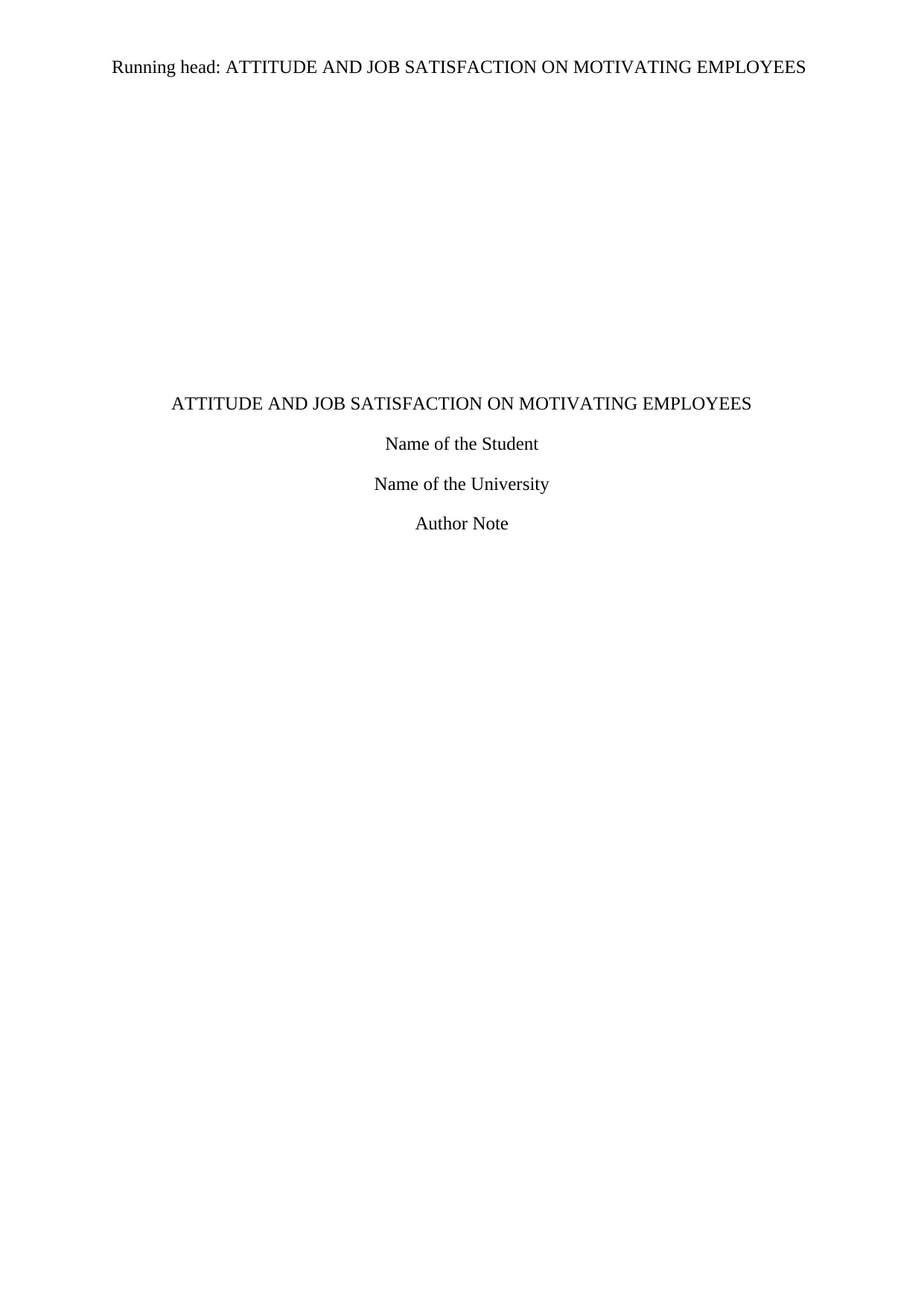
Running head: ATTITUDE AND JOB SATISFACTION ON MOTIVATING EMPLOYEES
ATTITUDE AND JOB SATISFACTION ON MOTIVATING EMPLOYEES
Name of the Student
Name of the University
Author Note
ATTITUDE AND JOB SATISFACTION ON MOTIVATING EMPLOYEES
Name of the Student
Name of the University
Author Note
Paraphrase This Document
Need a fresh take? Get an instant paraphrase of this document with our AI Paraphraser

1ATTITUDE AND JOB SATISFACTION ON MOTIVATING EMPLOYEES
toc
toc
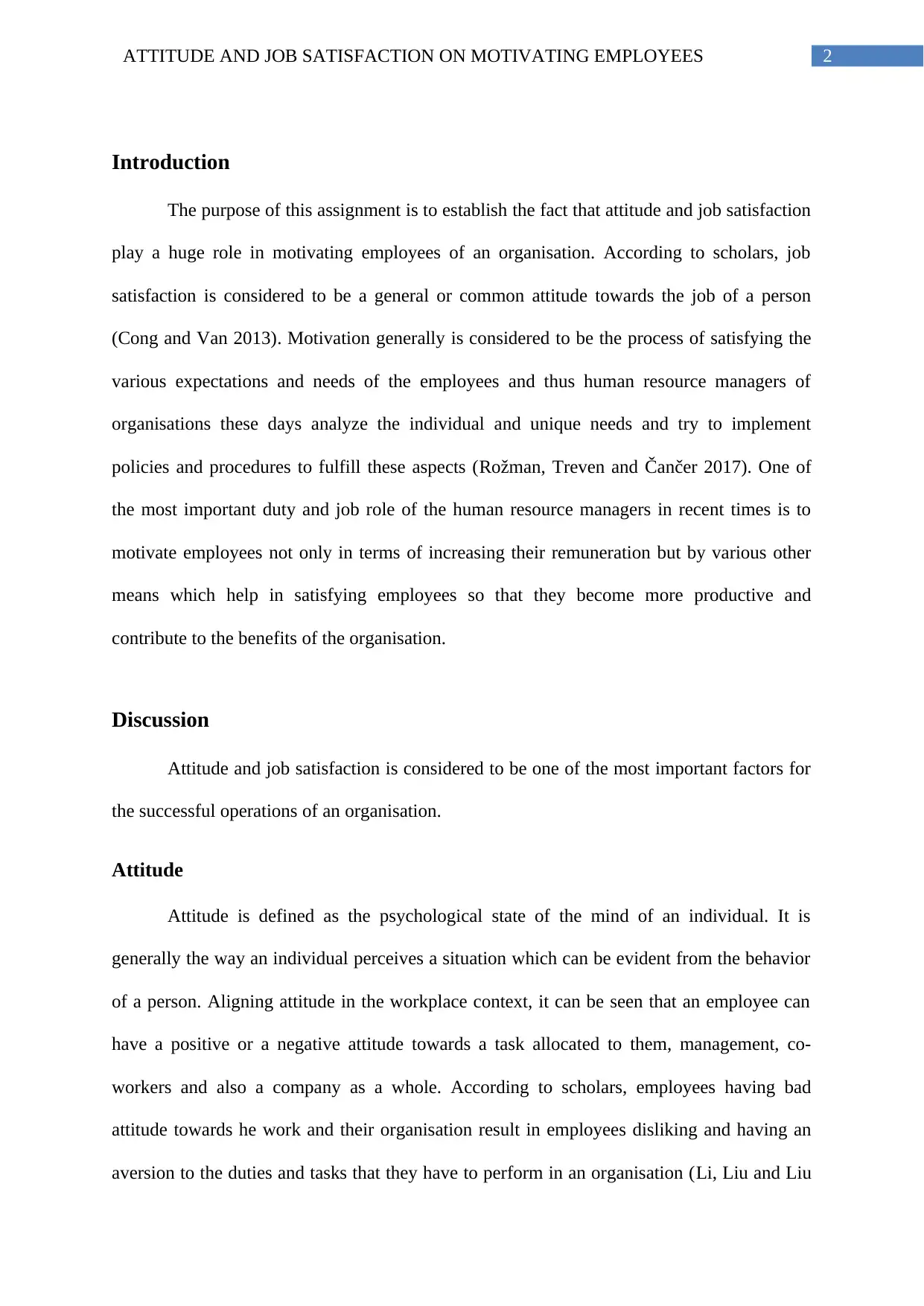
2ATTITUDE AND JOB SATISFACTION ON MOTIVATING EMPLOYEES
Introduction
The purpose of this assignment is to establish the fact that attitude and job satisfaction
play a huge role in motivating employees of an organisation. According to scholars, job
satisfaction is considered to be a general or common attitude towards the job of a person
(Cong and Van 2013). Motivation generally is considered to be the process of satisfying the
various expectations and needs of the employees and thus human resource managers of
organisations these days analyze the individual and unique needs and try to implement
policies and procedures to fulfill these aspects (Rožman, Treven and Čančer 2017). One of
the most important duty and job role of the human resource managers in recent times is to
motivate employees not only in terms of increasing their remuneration but by various other
means which help in satisfying employees so that they become more productive and
contribute to the benefits of the organisation.
Discussion
Attitude and job satisfaction is considered to be one of the most important factors for
the successful operations of an organisation.
Attitude
Attitude is defined as the psychological state of the mind of an individual. It is
generally the way an individual perceives a situation which can be evident from the behavior
of a person. Aligning attitude in the workplace context, it can be seen that an employee can
have a positive or a negative attitude towards a task allocated to them, management, co-
workers and also a company as a whole. According to scholars, employees having bad
attitude towards he work and their organisation result in employees disliking and having an
aversion to the duties and tasks that they have to perform in an organisation (Li, Liu and Liu
Introduction
The purpose of this assignment is to establish the fact that attitude and job satisfaction
play a huge role in motivating employees of an organisation. According to scholars, job
satisfaction is considered to be a general or common attitude towards the job of a person
(Cong and Van 2013). Motivation generally is considered to be the process of satisfying the
various expectations and needs of the employees and thus human resource managers of
organisations these days analyze the individual and unique needs and try to implement
policies and procedures to fulfill these aspects (Rožman, Treven and Čančer 2017). One of
the most important duty and job role of the human resource managers in recent times is to
motivate employees not only in terms of increasing their remuneration but by various other
means which help in satisfying employees so that they become more productive and
contribute to the benefits of the organisation.
Discussion
Attitude and job satisfaction is considered to be one of the most important factors for
the successful operations of an organisation.
Attitude
Attitude is defined as the psychological state of the mind of an individual. It is
generally the way an individual perceives a situation which can be evident from the behavior
of a person. Aligning attitude in the workplace context, it can be seen that an employee can
have a positive or a negative attitude towards a task allocated to them, management, co-
workers and also a company as a whole. According to scholars, employees having bad
attitude towards he work and their organisation result in employees disliking and having an
aversion to the duties and tasks that they have to perform in an organisation (Li, Liu and Liu
⊘ This is a preview!⊘
Do you want full access?
Subscribe today to unlock all pages.

Trusted by 1+ million students worldwide
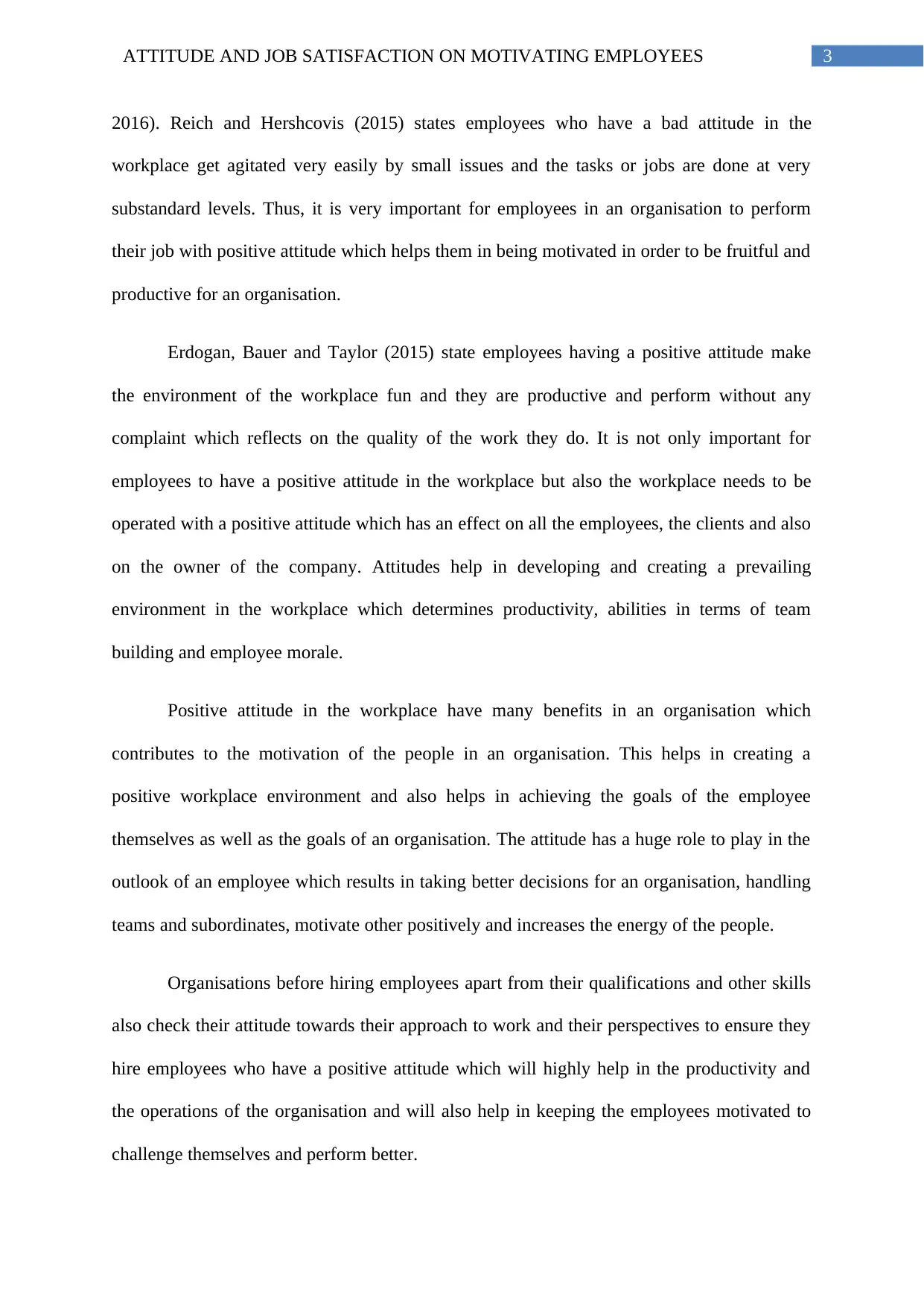
3ATTITUDE AND JOB SATISFACTION ON MOTIVATING EMPLOYEES
2016). Reich and Hershcovis (2015) states employees who have a bad attitude in the
workplace get agitated very easily by small issues and the tasks or jobs are done at very
substandard levels. Thus, it is very important for employees in an organisation to perform
their job with positive attitude which helps them in being motivated in order to be fruitful and
productive for an organisation.
Erdogan, Bauer and Taylor (2015) state employees having a positive attitude make
the environment of the workplace fun and they are productive and perform without any
complaint which reflects on the quality of the work they do. It is not only important for
employees to have a positive attitude in the workplace but also the workplace needs to be
operated with a positive attitude which has an effect on all the employees, the clients and also
on the owner of the company. Attitudes help in developing and creating a prevailing
environment in the workplace which determines productivity, abilities in terms of team
building and employee morale.
Positive attitude in the workplace have many benefits in an organisation which
contributes to the motivation of the people in an organisation. This helps in creating a
positive workplace environment and also helps in achieving the goals of the employee
themselves as well as the goals of an organisation. The attitude has a huge role to play in the
outlook of an employee which results in taking better decisions for an organisation, handling
teams and subordinates, motivate other positively and increases the energy of the people.
Organisations before hiring employees apart from their qualifications and other skills
also check their attitude towards their approach to work and their perspectives to ensure they
hire employees who have a positive attitude which will highly help in the productivity and
the operations of the organisation and will also help in keeping the employees motivated to
challenge themselves and perform better.
2016). Reich and Hershcovis (2015) states employees who have a bad attitude in the
workplace get agitated very easily by small issues and the tasks or jobs are done at very
substandard levels. Thus, it is very important for employees in an organisation to perform
their job with positive attitude which helps them in being motivated in order to be fruitful and
productive for an organisation.
Erdogan, Bauer and Taylor (2015) state employees having a positive attitude make
the environment of the workplace fun and they are productive and perform without any
complaint which reflects on the quality of the work they do. It is not only important for
employees to have a positive attitude in the workplace but also the workplace needs to be
operated with a positive attitude which has an effect on all the employees, the clients and also
on the owner of the company. Attitudes help in developing and creating a prevailing
environment in the workplace which determines productivity, abilities in terms of team
building and employee morale.
Positive attitude in the workplace have many benefits in an organisation which
contributes to the motivation of the people in an organisation. This helps in creating a
positive workplace environment and also helps in achieving the goals of the employee
themselves as well as the goals of an organisation. The attitude has a huge role to play in the
outlook of an employee which results in taking better decisions for an organisation, handling
teams and subordinates, motivate other positively and increases the energy of the people.
Organisations before hiring employees apart from their qualifications and other skills
also check their attitude towards their approach to work and their perspectives to ensure they
hire employees who have a positive attitude which will highly help in the productivity and
the operations of the organisation and will also help in keeping the employees motivated to
challenge themselves and perform better.
Paraphrase This Document
Need a fresh take? Get an instant paraphrase of this document with our AI Paraphraser
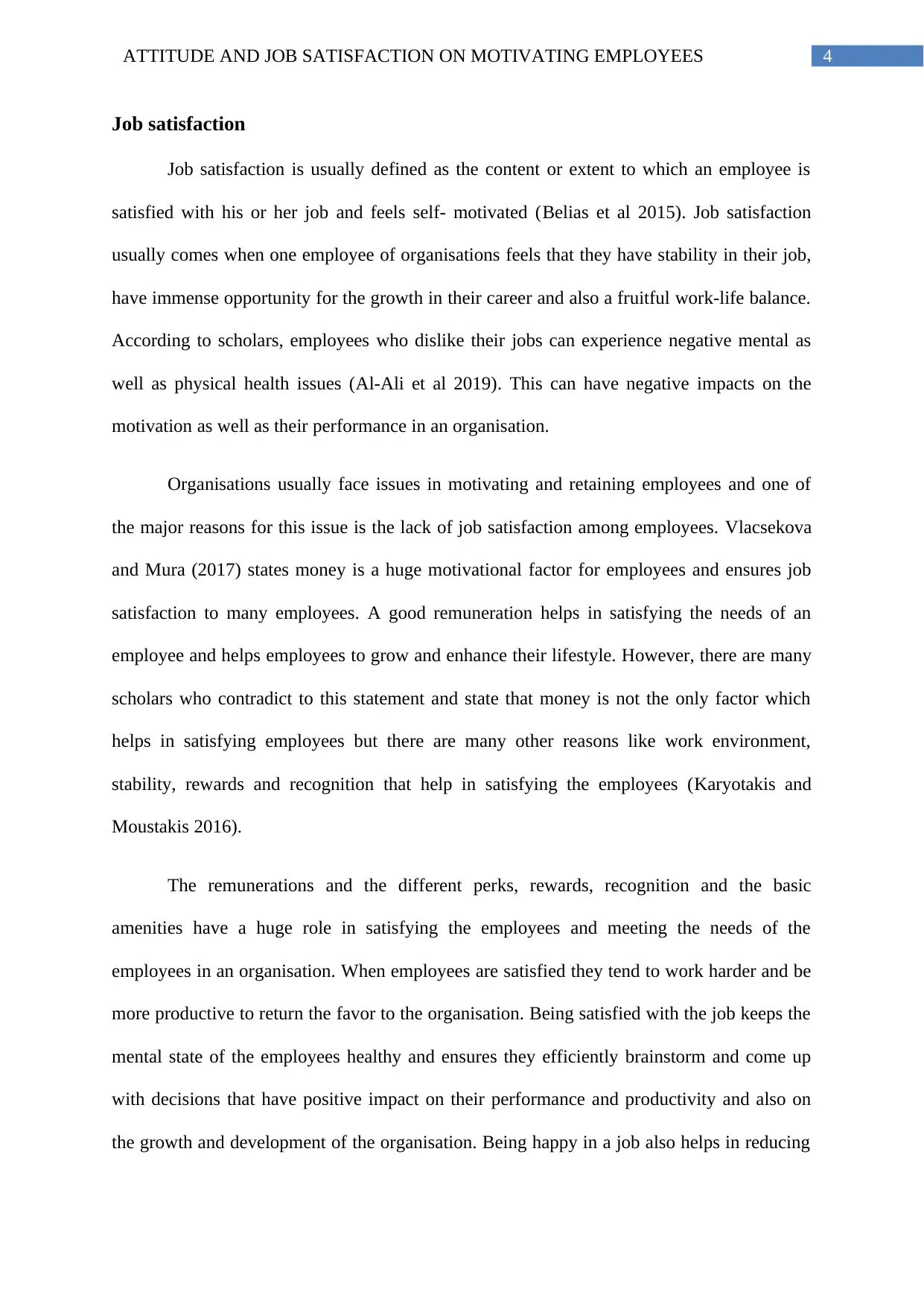
4ATTITUDE AND JOB SATISFACTION ON MOTIVATING EMPLOYEES
Job satisfaction
Job satisfaction is usually defined as the content or extent to which an employee is
satisfied with his or her job and feels self- motivated (Belias et al 2015). Job satisfaction
usually comes when one employee of organisations feels that they have stability in their job,
have immense opportunity for the growth in their career and also a fruitful work-life balance.
According to scholars, employees who dislike their jobs can experience negative mental as
well as physical health issues (Al-Ali et al 2019). This can have negative impacts on the
motivation as well as their performance in an organisation.
Organisations usually face issues in motivating and retaining employees and one of
the major reasons for this issue is the lack of job satisfaction among employees. Vlacsekova
and Mura (2017) states money is a huge motivational factor for employees and ensures job
satisfaction to many employees. A good remuneration helps in satisfying the needs of an
employee and helps employees to grow and enhance their lifestyle. However, there are many
scholars who contradict to this statement and state that money is not the only factor which
helps in satisfying employees but there are many other reasons like work environment,
stability, rewards and recognition that help in satisfying the employees (Karyotakis and
Moustakis 2016).
The remunerations and the different perks, rewards, recognition and the basic
amenities have a huge role in satisfying the employees and meeting the needs of the
employees in an organisation. When employees are satisfied they tend to work harder and be
more productive to return the favor to the organisation. Being satisfied with the job keeps the
mental state of the employees healthy and ensures they efficiently brainstorm and come up
with decisions that have positive impact on their performance and productivity and also on
the growth and development of the organisation. Being happy in a job also helps in reducing
Job satisfaction
Job satisfaction is usually defined as the content or extent to which an employee is
satisfied with his or her job and feels self- motivated (Belias et al 2015). Job satisfaction
usually comes when one employee of organisations feels that they have stability in their job,
have immense opportunity for the growth in their career and also a fruitful work-life balance.
According to scholars, employees who dislike their jobs can experience negative mental as
well as physical health issues (Al-Ali et al 2019). This can have negative impacts on the
motivation as well as their performance in an organisation.
Organisations usually face issues in motivating and retaining employees and one of
the major reasons for this issue is the lack of job satisfaction among employees. Vlacsekova
and Mura (2017) states money is a huge motivational factor for employees and ensures job
satisfaction to many employees. A good remuneration helps in satisfying the needs of an
employee and helps employees to grow and enhance their lifestyle. However, there are many
scholars who contradict to this statement and state that money is not the only factor which
helps in satisfying employees but there are many other reasons like work environment,
stability, rewards and recognition that help in satisfying the employees (Karyotakis and
Moustakis 2016).
The remunerations and the different perks, rewards, recognition and the basic
amenities have a huge role in satisfying the employees and meeting the needs of the
employees in an organisation. When employees are satisfied they tend to work harder and be
more productive to return the favor to the organisation. Being satisfied with the job keeps the
mental state of the employees healthy and ensures they efficiently brainstorm and come up
with decisions that have positive impact on their performance and productivity and also on
the growth and development of the organisation. Being happy in a job also helps in reducing
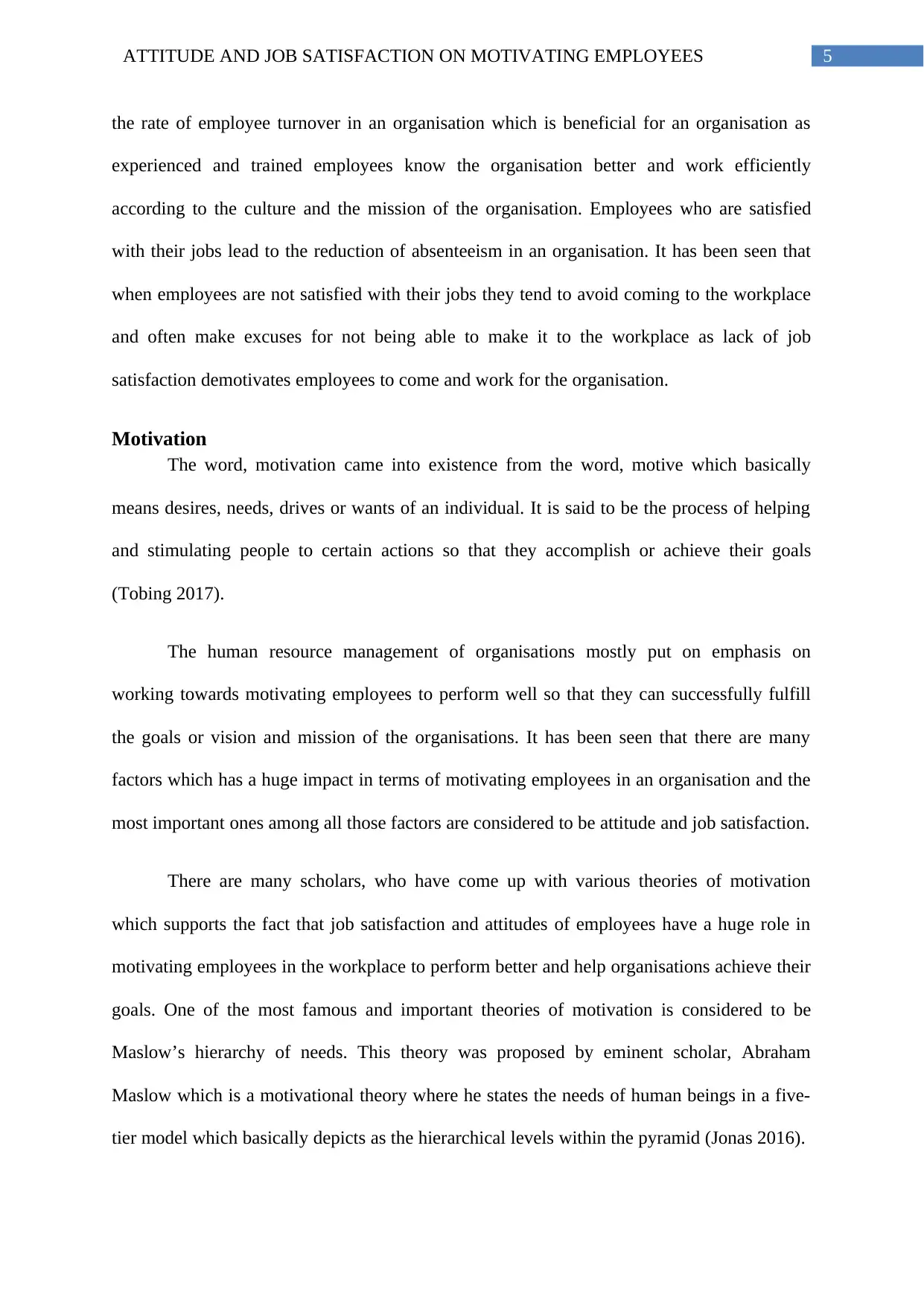
5ATTITUDE AND JOB SATISFACTION ON MOTIVATING EMPLOYEES
the rate of employee turnover in an organisation which is beneficial for an organisation as
experienced and trained employees know the organisation better and work efficiently
according to the culture and the mission of the organisation. Employees who are satisfied
with their jobs lead to the reduction of absenteeism in an organisation. It has been seen that
when employees are not satisfied with their jobs they tend to avoid coming to the workplace
and often make excuses for not being able to make it to the workplace as lack of job
satisfaction demotivates employees to come and work for the organisation.
Motivation
The word, motivation came into existence from the word, motive which basically
means desires, needs, drives or wants of an individual. It is said to be the process of helping
and stimulating people to certain actions so that they accomplish or achieve their goals
(Tobing 2017).
The human resource management of organisations mostly put on emphasis on
working towards motivating employees to perform well so that they can successfully fulfill
the goals or vision and mission of the organisations. It has been seen that there are many
factors which has a huge impact in terms of motivating employees in an organisation and the
most important ones among all those factors are considered to be attitude and job satisfaction.
There are many scholars, who have come up with various theories of motivation
which supports the fact that job satisfaction and attitudes of employees have a huge role in
motivating employees in the workplace to perform better and help organisations achieve their
goals. One of the most famous and important theories of motivation is considered to be
Maslow’s hierarchy of needs. This theory was proposed by eminent scholar, Abraham
Maslow which is a motivational theory where he states the needs of human beings in a five-
tier model which basically depicts as the hierarchical levels within the pyramid (Jonas 2016).
the rate of employee turnover in an organisation which is beneficial for an organisation as
experienced and trained employees know the organisation better and work efficiently
according to the culture and the mission of the organisation. Employees who are satisfied
with their jobs lead to the reduction of absenteeism in an organisation. It has been seen that
when employees are not satisfied with their jobs they tend to avoid coming to the workplace
and often make excuses for not being able to make it to the workplace as lack of job
satisfaction demotivates employees to come and work for the organisation.
Motivation
The word, motivation came into existence from the word, motive which basically
means desires, needs, drives or wants of an individual. It is said to be the process of helping
and stimulating people to certain actions so that they accomplish or achieve their goals
(Tobing 2017).
The human resource management of organisations mostly put on emphasis on
working towards motivating employees to perform well so that they can successfully fulfill
the goals or vision and mission of the organisations. It has been seen that there are many
factors which has a huge impact in terms of motivating employees in an organisation and the
most important ones among all those factors are considered to be attitude and job satisfaction.
There are many scholars, who have come up with various theories of motivation
which supports the fact that job satisfaction and attitudes of employees have a huge role in
motivating employees in the workplace to perform better and help organisations achieve their
goals. One of the most famous and important theories of motivation is considered to be
Maslow’s hierarchy of needs. This theory was proposed by eminent scholar, Abraham
Maslow which is a motivational theory where he states the needs of human beings in a five-
tier model which basically depicts as the hierarchical levels within the pyramid (Jonas 2016).
⊘ This is a preview!⊘
Do you want full access?
Subscribe today to unlock all pages.

Trusted by 1+ million students worldwide
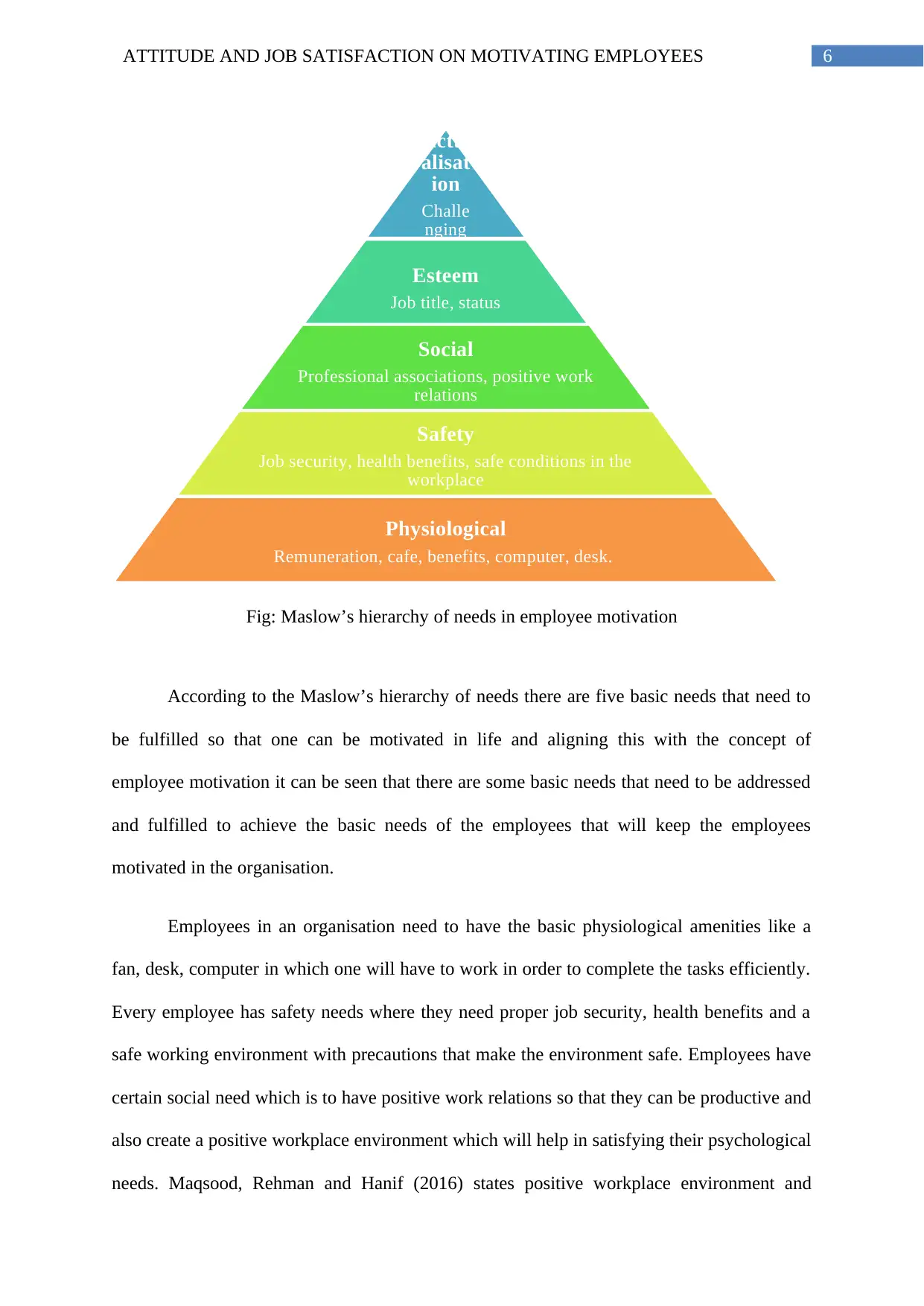
6ATTITUDE AND JOB SATISFACTION ON MOTIVATING EMPLOYEES
Fig: Maslow’s hierarchy of needs in employee motivation
According to the Maslow’s hierarchy of needs there are five basic needs that need to
be fulfilled so that one can be motivated in life and aligning this with the concept of
employee motivation it can be seen that there are some basic needs that need to be addressed
and fulfilled to achieve the basic needs of the employees that will keep the employees
motivated in the organisation.
Employees in an organisation need to have the basic physiological amenities like a
fan, desk, computer in which one will have to work in order to complete the tasks efficiently.
Every employee has safety needs where they need proper job security, health benefits and a
safe working environment with precautions that make the environment safe. Employees have
certain social need which is to have positive work relations so that they can be productive and
also create a positive workplace environment which will help in satisfying their psychological
needs. Maqsood, Rehman and Hanif (2016) states positive workplace environment and
Self
actu
alisat
ion
Challe
nging
job,
achiev
ementEsteem
Job title, status
Social
Professional associations, positive work
relations
Safety
Job security, health benefits, safe conditions in the
workplace
Physiological
Remuneration, cafe, benefits, computer, desk.
Fig: Maslow’s hierarchy of needs in employee motivation
According to the Maslow’s hierarchy of needs there are five basic needs that need to
be fulfilled so that one can be motivated in life and aligning this with the concept of
employee motivation it can be seen that there are some basic needs that need to be addressed
and fulfilled to achieve the basic needs of the employees that will keep the employees
motivated in the organisation.
Employees in an organisation need to have the basic physiological amenities like a
fan, desk, computer in which one will have to work in order to complete the tasks efficiently.
Every employee has safety needs where they need proper job security, health benefits and a
safe working environment with precautions that make the environment safe. Employees have
certain social need which is to have positive work relations so that they can be productive and
also create a positive workplace environment which will help in satisfying their psychological
needs. Maqsood, Rehman and Hanif (2016) states positive workplace environment and
Self
actu
alisat
ion
Challe
nging
job,
achiev
ementEsteem
Job title, status
Social
Professional associations, positive work
relations
Safety
Job security, health benefits, safe conditions in the
workplace
Physiological
Remuneration, cafe, benefits, computer, desk.
Paraphrase This Document
Need a fresh take? Get an instant paraphrase of this document with our AI Paraphraser
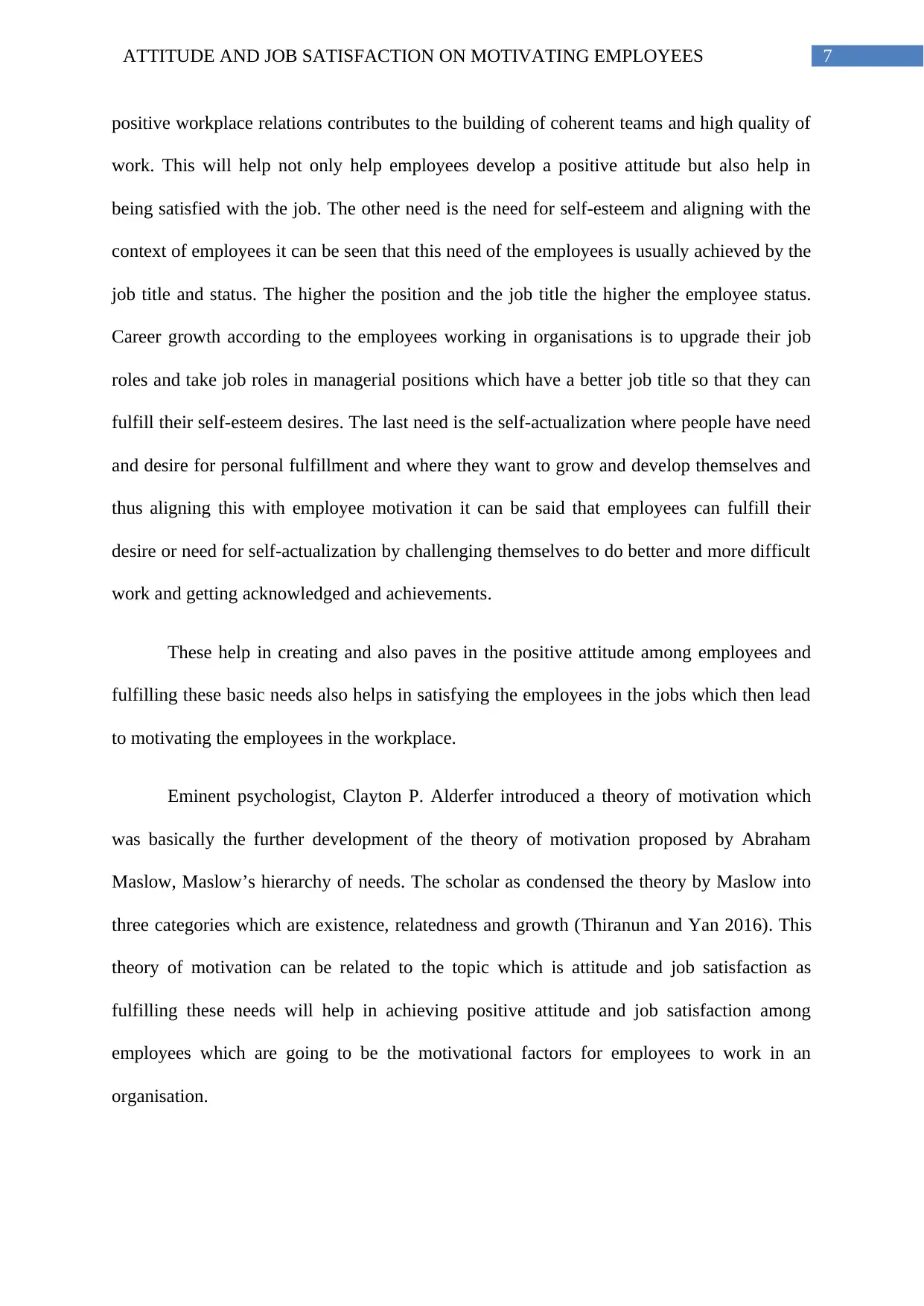
7ATTITUDE AND JOB SATISFACTION ON MOTIVATING EMPLOYEES
positive workplace relations contributes to the building of coherent teams and high quality of
work. This will help not only help employees develop a positive attitude but also help in
being satisfied with the job. The other need is the need for self-esteem and aligning with the
context of employees it can be seen that this need of the employees is usually achieved by the
job title and status. The higher the position and the job title the higher the employee status.
Career growth according to the employees working in organisations is to upgrade their job
roles and take job roles in managerial positions which have a better job title so that they can
fulfill their self-esteem desires. The last need is the self-actualization where people have need
and desire for personal fulfillment and where they want to grow and develop themselves and
thus aligning this with employee motivation it can be said that employees can fulfill their
desire or need for self-actualization by challenging themselves to do better and more difficult
work and getting acknowledged and achievements.
These help in creating and also paves in the positive attitude among employees and
fulfilling these basic needs also helps in satisfying the employees in the jobs which then lead
to motivating the employees in the workplace.
Eminent psychologist, Clayton P. Alderfer introduced a theory of motivation which
was basically the further development of the theory of motivation proposed by Abraham
Maslow, Maslow’s hierarchy of needs. The scholar as condensed the theory by Maslow into
three categories which are existence, relatedness and growth (Thiranun and Yan 2016). This
theory of motivation can be related to the topic which is attitude and job satisfaction as
fulfilling these needs will help in achieving positive attitude and job satisfaction among
employees which are going to be the motivational factors for employees to work in an
organisation.
positive workplace relations contributes to the building of coherent teams and high quality of
work. This will help not only help employees develop a positive attitude but also help in
being satisfied with the job. The other need is the need for self-esteem and aligning with the
context of employees it can be seen that this need of the employees is usually achieved by the
job title and status. The higher the position and the job title the higher the employee status.
Career growth according to the employees working in organisations is to upgrade their job
roles and take job roles in managerial positions which have a better job title so that they can
fulfill their self-esteem desires. The last need is the self-actualization where people have need
and desire for personal fulfillment and where they want to grow and develop themselves and
thus aligning this with employee motivation it can be said that employees can fulfill their
desire or need for self-actualization by challenging themselves to do better and more difficult
work and getting acknowledged and achievements.
These help in creating and also paves in the positive attitude among employees and
fulfilling these basic needs also helps in satisfying the employees in the jobs which then lead
to motivating the employees in the workplace.
Eminent psychologist, Clayton P. Alderfer introduced a theory of motivation which
was basically the further development of the theory of motivation proposed by Abraham
Maslow, Maslow’s hierarchy of needs. The scholar as condensed the theory by Maslow into
three categories which are existence, relatedness and growth (Thiranun and Yan 2016). This
theory of motivation can be related to the topic which is attitude and job satisfaction as
fulfilling these needs will help in achieving positive attitude and job satisfaction among
employees which are going to be the motivational factors for employees to work in an
organisation.
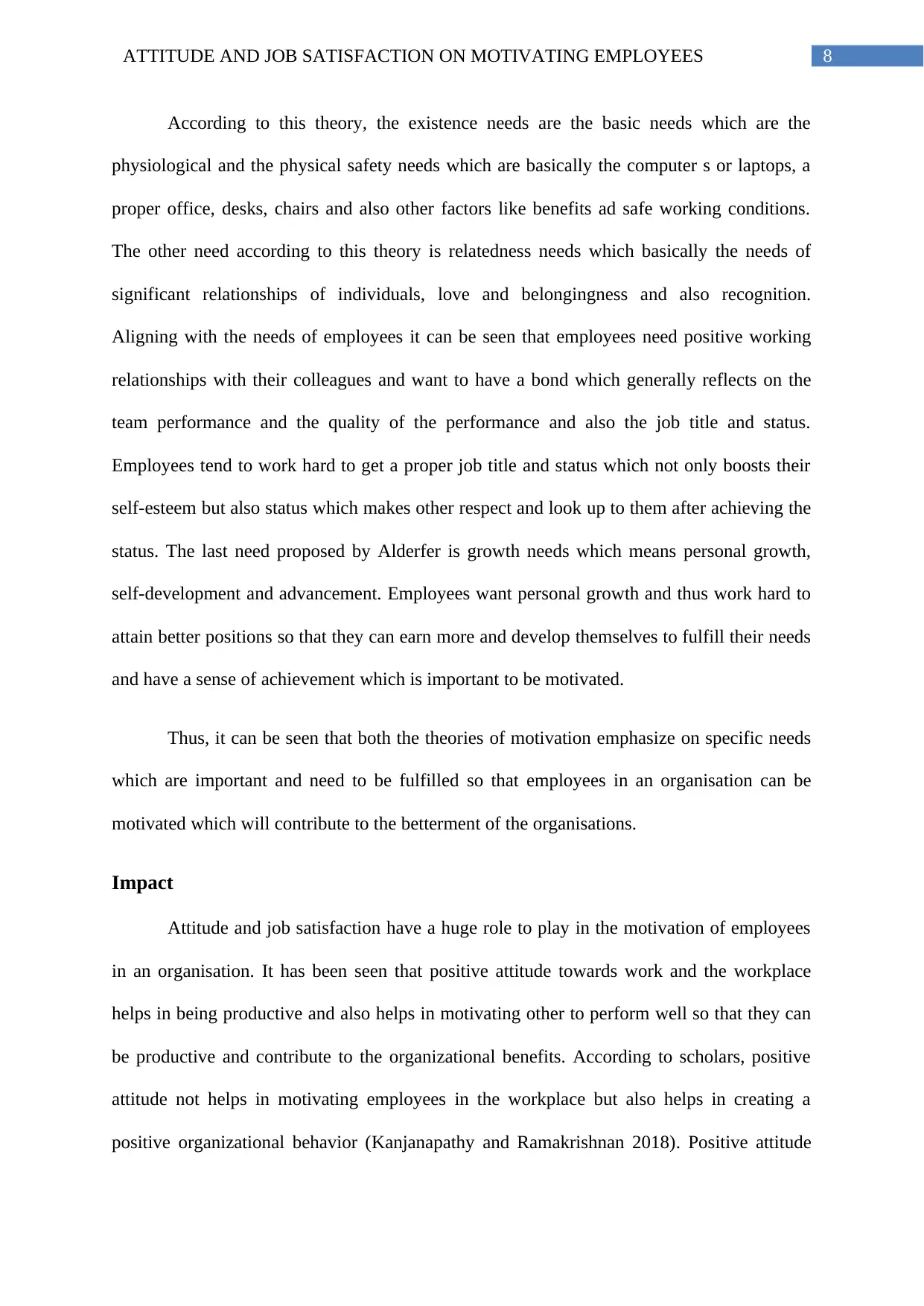
8ATTITUDE AND JOB SATISFACTION ON MOTIVATING EMPLOYEES
According to this theory, the existence needs are the basic needs which are the
physiological and the physical safety needs which are basically the computer s or laptops, a
proper office, desks, chairs and also other factors like benefits ad safe working conditions.
The other need according to this theory is relatedness needs which basically the needs of
significant relationships of individuals, love and belongingness and also recognition.
Aligning with the needs of employees it can be seen that employees need positive working
relationships with their colleagues and want to have a bond which generally reflects on the
team performance and the quality of the performance and also the job title and status.
Employees tend to work hard to get a proper job title and status which not only boosts their
self-esteem but also status which makes other respect and look up to them after achieving the
status. The last need proposed by Alderfer is growth needs which means personal growth,
self-development and advancement. Employees want personal growth and thus work hard to
attain better positions so that they can earn more and develop themselves to fulfill their needs
and have a sense of achievement which is important to be motivated.
Thus, it can be seen that both the theories of motivation emphasize on specific needs
which are important and need to be fulfilled so that employees in an organisation can be
motivated which will contribute to the betterment of the organisations.
Impact
Attitude and job satisfaction have a huge role to play in the motivation of employees
in an organisation. It has been seen that positive attitude towards work and the workplace
helps in being productive and also helps in motivating other to perform well so that they can
be productive and contribute to the organizational benefits. According to scholars, positive
attitude not helps in motivating employees in the workplace but also helps in creating a
positive organizational behavior (Kanjanapathy and Ramakrishnan 2018). Positive attitude
According to this theory, the existence needs are the basic needs which are the
physiological and the physical safety needs which are basically the computer s or laptops, a
proper office, desks, chairs and also other factors like benefits ad safe working conditions.
The other need according to this theory is relatedness needs which basically the needs of
significant relationships of individuals, love and belongingness and also recognition.
Aligning with the needs of employees it can be seen that employees need positive working
relationships with their colleagues and want to have a bond which generally reflects on the
team performance and the quality of the performance and also the job title and status.
Employees tend to work hard to get a proper job title and status which not only boosts their
self-esteem but also status which makes other respect and look up to them after achieving the
status. The last need proposed by Alderfer is growth needs which means personal growth,
self-development and advancement. Employees want personal growth and thus work hard to
attain better positions so that they can earn more and develop themselves to fulfill their needs
and have a sense of achievement which is important to be motivated.
Thus, it can be seen that both the theories of motivation emphasize on specific needs
which are important and need to be fulfilled so that employees in an organisation can be
motivated which will contribute to the betterment of the organisations.
Impact
Attitude and job satisfaction have a huge role to play in the motivation of employees
in an organisation. It has been seen that positive attitude towards work and the workplace
helps in being productive and also helps in motivating other to perform well so that they can
be productive and contribute to the organizational benefits. According to scholars, positive
attitude not helps in motivating employees in the workplace but also helps in creating a
positive organizational behavior (Kanjanapathy and Ramakrishnan 2018). Positive attitude
⊘ This is a preview!⊘
Do you want full access?
Subscribe today to unlock all pages.

Trusted by 1+ million students worldwide
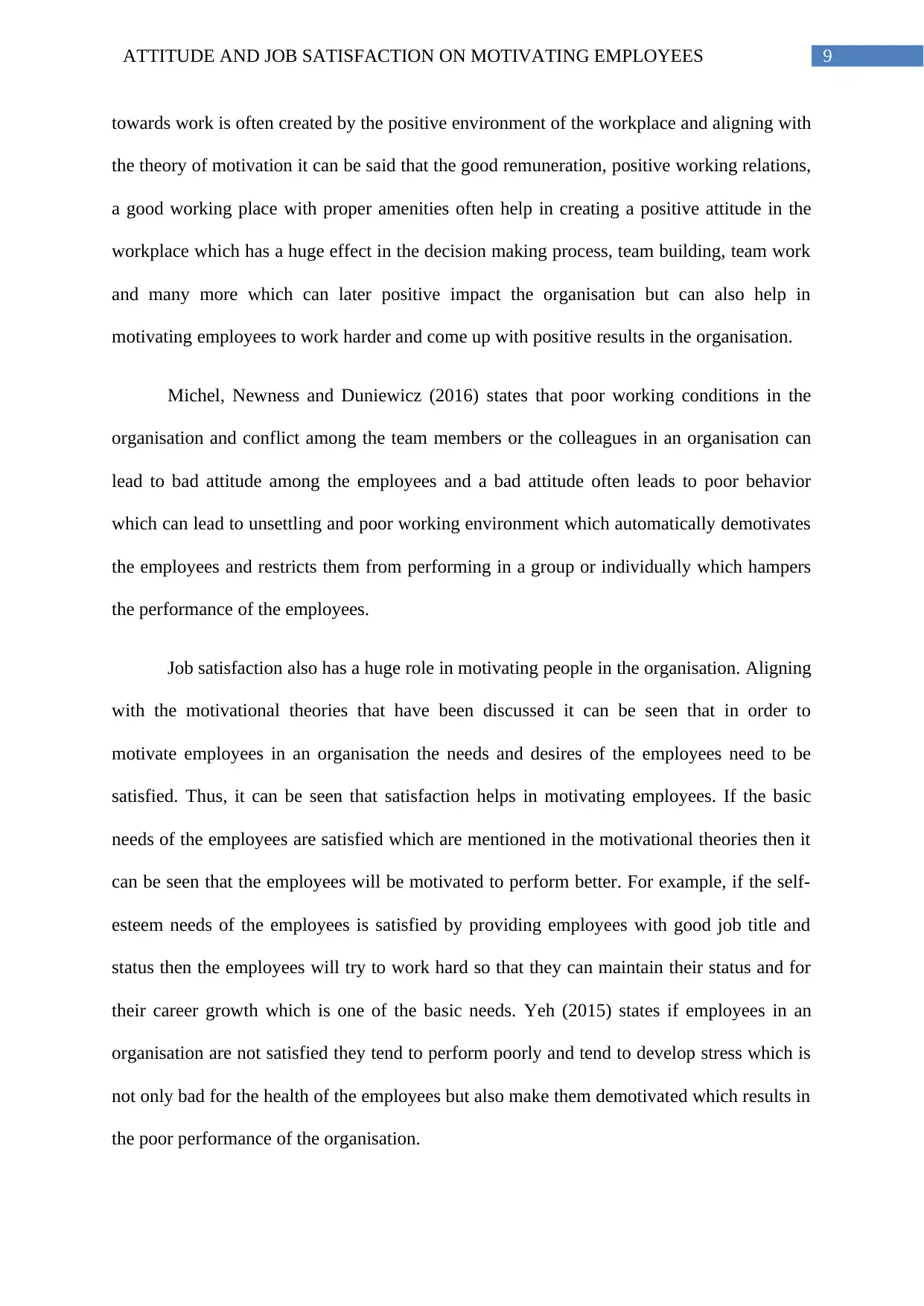
9ATTITUDE AND JOB SATISFACTION ON MOTIVATING EMPLOYEES
towards work is often created by the positive environment of the workplace and aligning with
the theory of motivation it can be said that the good remuneration, positive working relations,
a good working place with proper amenities often help in creating a positive attitude in the
workplace which has a huge effect in the decision making process, team building, team work
and many more which can later positive impact the organisation but can also help in
motivating employees to work harder and come up with positive results in the organisation.
Michel, Newness and Duniewicz (2016) states that poor working conditions in the
organisation and conflict among the team members or the colleagues in an organisation can
lead to bad attitude among the employees and a bad attitude often leads to poor behavior
which can lead to unsettling and poor working environment which automatically demotivates
the employees and restricts them from performing in a group or individually which hampers
the performance of the employees.
Job satisfaction also has a huge role in motivating people in the organisation. Aligning
with the motivational theories that have been discussed it can be seen that in order to
motivate employees in an organisation the needs and desires of the employees need to be
satisfied. Thus, it can be seen that satisfaction helps in motivating employees. If the basic
needs of the employees are satisfied which are mentioned in the motivational theories then it
can be seen that the employees will be motivated to perform better. For example, if the self-
esteem needs of the employees is satisfied by providing employees with good job title and
status then the employees will try to work hard so that they can maintain their status and for
their career growth which is one of the basic needs. Yeh (2015) states if employees in an
organisation are not satisfied they tend to perform poorly and tend to develop stress which is
not only bad for the health of the employees but also make them demotivated which results in
the poor performance of the organisation.
towards work is often created by the positive environment of the workplace and aligning with
the theory of motivation it can be said that the good remuneration, positive working relations,
a good working place with proper amenities often help in creating a positive attitude in the
workplace which has a huge effect in the decision making process, team building, team work
and many more which can later positive impact the organisation but can also help in
motivating employees to work harder and come up with positive results in the organisation.
Michel, Newness and Duniewicz (2016) states that poor working conditions in the
organisation and conflict among the team members or the colleagues in an organisation can
lead to bad attitude among the employees and a bad attitude often leads to poor behavior
which can lead to unsettling and poor working environment which automatically demotivates
the employees and restricts them from performing in a group or individually which hampers
the performance of the employees.
Job satisfaction also has a huge role in motivating people in the organisation. Aligning
with the motivational theories that have been discussed it can be seen that in order to
motivate employees in an organisation the needs and desires of the employees need to be
satisfied. Thus, it can be seen that satisfaction helps in motivating employees. If the basic
needs of the employees are satisfied which are mentioned in the motivational theories then it
can be seen that the employees will be motivated to perform better. For example, if the self-
esteem needs of the employees is satisfied by providing employees with good job title and
status then the employees will try to work hard so that they can maintain their status and for
their career growth which is one of the basic needs. Yeh (2015) states if employees in an
organisation are not satisfied they tend to perform poorly and tend to develop stress which is
not only bad for the health of the employees but also make them demotivated which results in
the poor performance of the organisation.
Paraphrase This Document
Need a fresh take? Get an instant paraphrase of this document with our AI Paraphraser

10ATTITUDE AND JOB SATISFACTION ON MOTIVATING EMPLOYEES
Thus, it can be seen that attitude and job satisfaction has a huge role to play in the
motivation of employees and thus organisations need to focus on encouraging people to have
positive attitudes towards their work and maintain the activities so that the employees in the
organisations are satisfied with their jobs which will lead to the employees being motivated.
Conclusion
Attitude and job satisfaction have a huge role to play in the motivation of employees
and it is important that human resource managers of organisations put emphasis on
implement activities and policies in the organisation to encourage people having a positive
attitude towards their work and also attaining full employee satisfaction. Motivation among
employees will not only help in enhancing the performance of the employees but will also
help in improving the productivity of the organisation which will help in the growth and
development of the organisation and also the employee.
Thus, it can be seen that attitude and job satisfaction has a huge role to play in the
motivation of employees and thus organisations need to focus on encouraging people to have
positive attitudes towards their work and maintain the activities so that the employees in the
organisations are satisfied with their jobs which will lead to the employees being motivated.
Conclusion
Attitude and job satisfaction have a huge role to play in the motivation of employees
and it is important that human resource managers of organisations put emphasis on
implement activities and policies in the organisation to encourage people having a positive
attitude towards their work and also attaining full employee satisfaction. Motivation among
employees will not only help in enhancing the performance of the employees but will also
help in improving the productivity of the organisation which will help in the growth and
development of the organisation and also the employee.
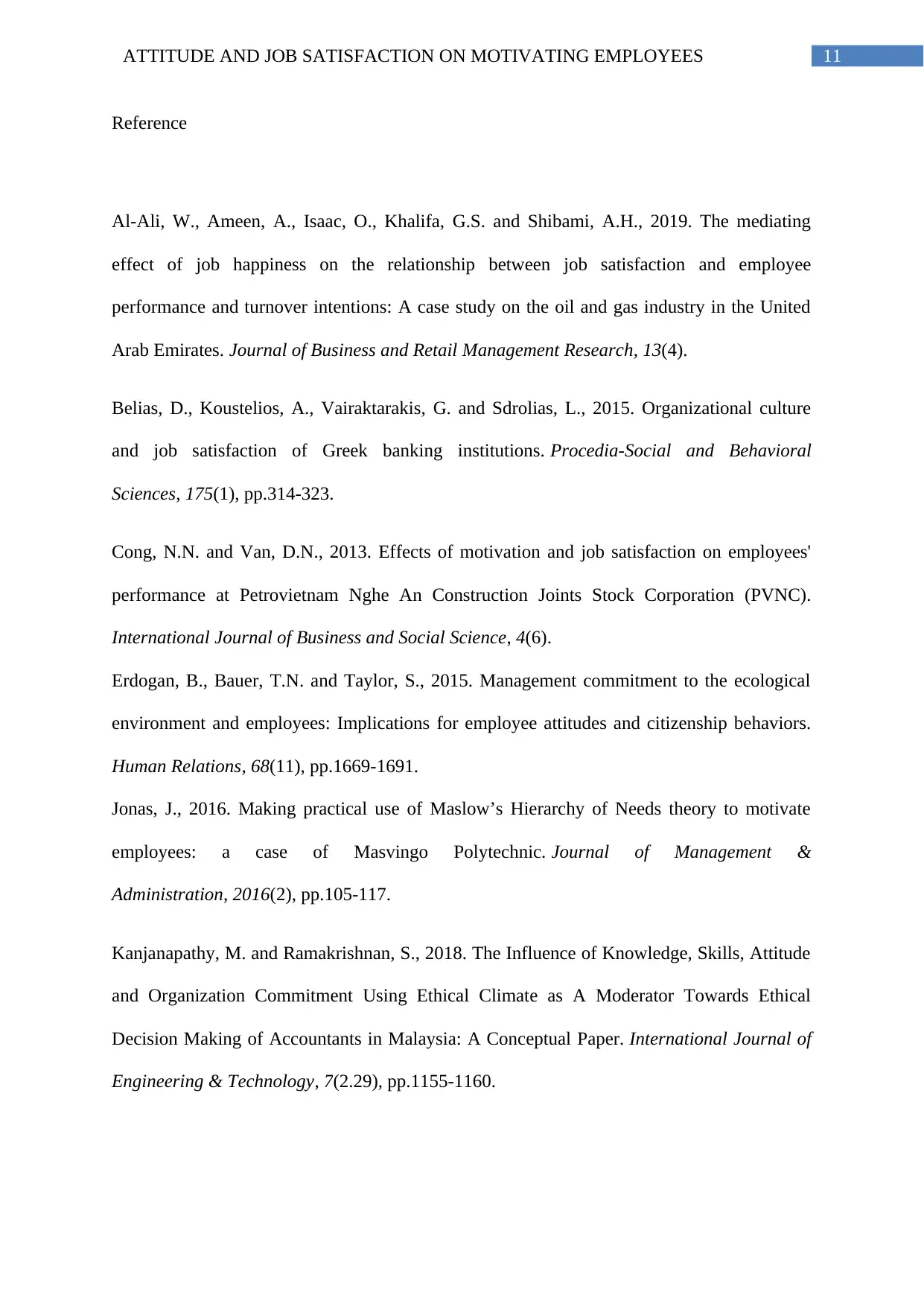
11ATTITUDE AND JOB SATISFACTION ON MOTIVATING EMPLOYEES
Reference
Al-Ali, W., Ameen, A., Isaac, O., Khalifa, G.S. and Shibami, A.H., 2019. The mediating
effect of job happiness on the relationship between job satisfaction and employee
performance and turnover intentions: A case study on the oil and gas industry in the United
Arab Emirates. Journal of Business and Retail Management Research, 13(4).
Belias, D., Koustelios, A., Vairaktarakis, G. and Sdrolias, L., 2015. Organizational culture
and job satisfaction of Greek banking institutions. Procedia-Social and Behavioral
Sciences, 175(1), pp.314-323.
Cong, N.N. and Van, D.N., 2013. Effects of motivation and job satisfaction on employees'
performance at Petrovietnam Nghe An Construction Joints Stock Corporation (PVNC).
International Journal of Business and Social Science, 4(6).
Erdogan, B., Bauer, T.N. and Taylor, S., 2015. Management commitment to the ecological
environment and employees: Implications for employee attitudes and citizenship behaviors.
Human Relations, 68(11), pp.1669-1691.
Jonas, J., 2016. Making practical use of Maslow’s Hierarchy of Needs theory to motivate
employees: a case of Masvingo Polytechnic. Journal of Management &
Administration, 2016(2), pp.105-117.
Kanjanapathy, M. and Ramakrishnan, S., 2018. The Influence of Knowledge, Skills, Attitude
and Organization Commitment Using Ethical Climate as A Moderator Towards Ethical
Decision Making of Accountants in Malaysia: A Conceptual Paper. International Journal of
Engineering & Technology, 7(2.29), pp.1155-1160.
Reference
Al-Ali, W., Ameen, A., Isaac, O., Khalifa, G.S. and Shibami, A.H., 2019. The mediating
effect of job happiness on the relationship between job satisfaction and employee
performance and turnover intentions: A case study on the oil and gas industry in the United
Arab Emirates. Journal of Business and Retail Management Research, 13(4).
Belias, D., Koustelios, A., Vairaktarakis, G. and Sdrolias, L., 2015. Organizational culture
and job satisfaction of Greek banking institutions. Procedia-Social and Behavioral
Sciences, 175(1), pp.314-323.
Cong, N.N. and Van, D.N., 2013. Effects of motivation and job satisfaction on employees'
performance at Petrovietnam Nghe An Construction Joints Stock Corporation (PVNC).
International Journal of Business and Social Science, 4(6).
Erdogan, B., Bauer, T.N. and Taylor, S., 2015. Management commitment to the ecological
environment and employees: Implications for employee attitudes and citizenship behaviors.
Human Relations, 68(11), pp.1669-1691.
Jonas, J., 2016. Making practical use of Maslow’s Hierarchy of Needs theory to motivate
employees: a case of Masvingo Polytechnic. Journal of Management &
Administration, 2016(2), pp.105-117.
Kanjanapathy, M. and Ramakrishnan, S., 2018. The Influence of Knowledge, Skills, Attitude
and Organization Commitment Using Ethical Climate as A Moderator Towards Ethical
Decision Making of Accountants in Malaysia: A Conceptual Paper. International Journal of
Engineering & Technology, 7(2.29), pp.1155-1160.
⊘ This is a preview!⊘
Do you want full access?
Subscribe today to unlock all pages.

Trusted by 1+ million students worldwide
1 out of 14
Related Documents
Your All-in-One AI-Powered Toolkit for Academic Success.
+13062052269
info@desklib.com
Available 24*7 on WhatsApp / Email
![[object Object]](/_next/static/media/star-bottom.7253800d.svg)
Unlock your academic potential
Copyright © 2020–2025 A2Z Services. All Rights Reserved. Developed and managed by ZUCOL.





